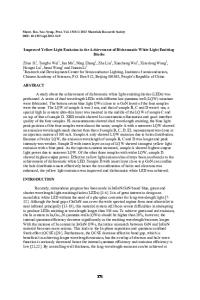Temperature behaviour of the yellow emission in GaN
- PDF / 164,192 Bytes
- 6 Pages / 612 x 792 pts (letter) Page_size
- 31 Downloads / 217 Views
Internet Journal o f
Nitride S emiconductor Research
Volume 2, Article 36
Temperature behaviour of the yellow emission in GaN R. Seitz, C. Gaspar, T. Monteiro, E. Pereira Departamento de Física, Universidade de Aveiro M. Leroux, B. Beaumont, Pierre Gibart Centre de Recherche sur l'Hetero-Epitaxie et ses Applications, CRHEA-CNRS This article was received on July 16, 1997 and accepted on September 15, 1997.
Abstract Even in good quality undoped GaN samples, as assessed by the intense excitonic emission, the yellow band is present. This band has been attributed either to a shallow donor to deep double donor pair recombination [1], to a deep donor to a shallow acceptor [2] or to a shallow donor and a deep state [3]. However, its origin is not yet clear. We present data on time resolved spectroscopy compared with steady state results. These results indicate that there is no difference in band shape between steady state and time resolved spectra at all temperatures. However, in some samples there is an increase in intensity of the yellow band. It is concluded that besides a fast emission, due to prompt excitation of the centre, an indirect path from a trap 13.7 meV below the shallow donor is responsible for the long component of the decay and the intensity increase. An emission with a lifetime of ca. 300 ms is also present with a maximum at 2.35 eV.
1. Introduction Photoluminescence (PL) measurements on nominally undoped n-type GaN bulk and epitaxial layers grown by different techniques on different substrates usually show besides the near band edge emission a broad yellow band with maximum at 2.25 eV [1] [2] [3] [4] [5]. It is known that GaN and its alloys are important materials for light-emitting devices as blue-UV lasers and LEDs, short-wavelength optical detectors and high-temperature electronics. However, the presence of unwanted deep states in the band gap due to native or extrinsic defects reduces the efficiency of devices. The yellow band has been attributed either to a shallow donor to a deep donor (acceptor) pair recombination [1] [2], to a deep double donor to a shallow acceptor [4] or to a shallow donor and a deep state [5]. The first model accounts for a binding energy of the acceptor at EA ≈ 860 meV [1] and a binding energy of the donor of E D › 35 meV [2]. In the second one, the donor state is located 700 meV below the conduction band (CB) while the acceptor level is located 200 meV above the valence band (VB). The third model agrees with a deep state near 1eV above the VB [5] not far from the energy of the deep acceptor of previous work [1] [2]. Currently most of the experimental evidence favours the first model. In order to clarify the recombination mechanisms involved in the yellow band emission different techniques as photoluminescence [1] [2] [3] [4] [5], optically detected magnetic resonance (ODMR) [2] [4], time resolved ODMR [6], photocapacitance [5], deep level transient spectroscopy (DLTS) [5], cathodoluminescence [7] [8] and PL under hydrostatic pressure [9] have been used. However its orig
Data Loading...











